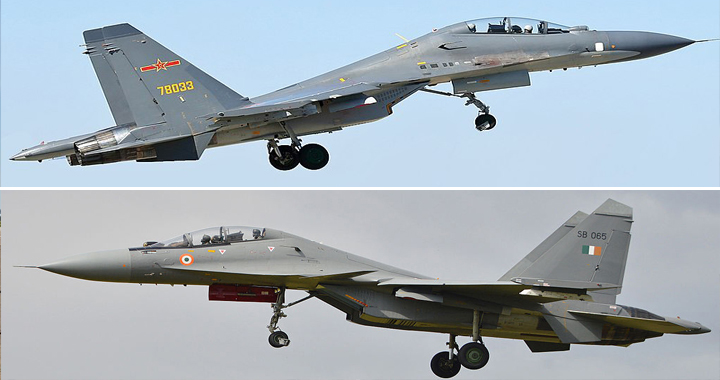
SOURCE: FIGHTER JET
As we have reported earlier that Indian Defence Ministry Approves Purchase Of 33 New Fighter Jets For Rs 18,148 crore. The Defence Ministry approved procurement of 21 MIG-29 and 12 Su-30 MKI aircraft along with the up-gradation of existing 59 Mig-29 jets.
This new order will add to the 272 fighters of the type already ordered by the Indian Air Force. The Su30MKI fleet is now the backbone of IAF and will continue to be so for the coming years. The Chinese air force, too, operates the Su30 fighters. Here is a comparison:
Su30MKI
- With more than 260 fighters in service, Su30MKI forms the bulk of IAF. Additional jets are still being manufactured by HAL at Nasik and production will continue for next 2-3 years. The Indian versions are different from other Su30s as they are tailored to the needs of IAF
- Designated MKI for India, the fighters have advanced Israeli avionics and an electronic warfare systems, making them different from the standard Su30
- Indian fighters have demonstrated Brahmos firing capabilities
- While they all have standard Russian origin R73/77 missiles, the Indian version will now be equipped with the longer-range Astra, the beyond visual range air-to-air missile developed by DRDO
- This will add a critical new capability to the aircraft that has till now been hampered by limited range to take down air targets, compared to the western platforms
- Though its beyond visual range combat ability is limited, at close quarters it has unbeatable capabilities
PLAAF’s Su30 MKK/MK2
- China operates two variants of Su30. The Sukhoi Su-30MKK (is a modification of the Sukhoi Su-30, incorporating advanced technology from the Sukhoi Su-35 variant.
- China had ordered 73 of the older MKK version and later added 24 of the MK2 version for its Navy
However, unlike the MKI, the Chinese version does not have thrust vectoring engines, making them less manoeuvrable and nimble than the Indian fighters
China’s Copycat Air Force
- China did not manufacture Su30s domestically, but it copied the design to make two indigenous versions called J11 and J16
- J11, which is based on Su27 platform, is the backbone of PLAAF, with 346 of the type ordered
- The more advanced version J16 is based on the Su30 platform and at least 128 are already in service. China has fitted the aircraft with indigenous weapons, including PL12 and PL15 air-to-air missiles
Chinese also copied another Sukhoi variant, Su33 for its Navy
Named J15, the aircraft carrier borne fighters have been copied from a suspected Ukrainian prototype that was surreptitiously acquired by China. At least 50 of these are believed to be in service
https://defencenewsofindia.com/iafs-sukhoi-su-30mki-vs-plaafs-sukhoi-su-30-mkk-mk2/






